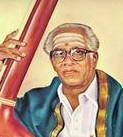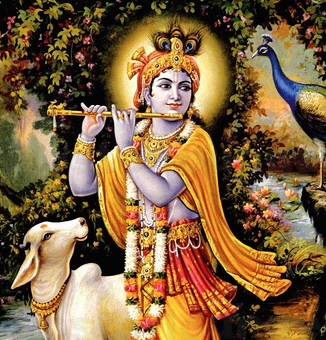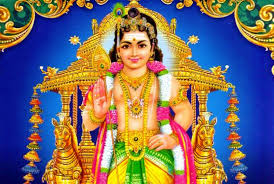
COMPOSER Suchindram S P Sivasubramaniam |
|
|||||||||||||
|
Suchindram S P Sivasubramaniam was a multi-faceted genius who hailed from Kanyakumari District in southern Tamizh Nadu. His life was one of complete devotion to music, and he was not only a brilliant vocalist and violinist and a dedicated guru, but also a highly inspired composer who gave to the world a great treasure of compositions in the classical and devotional, as well as Harikatha and patriotic genres.
Sivasubramaniam was born on 12th September 1917 in Vagaikulam, Tirunelveli District, southern Tamizh Nadu. He was introduced to music at a young age by his mother, who was an ardent music-lover, and he developed a great passion for the art. He began his musical journey as a vocalist, and was self-taught; he learnt and practised entirely on his own, finding guidance and inspiration in the music of the great masters and striving tirelessly to follow in their footsteps. With his passion and hard work, he became a reputed performing artiste by his teenage years. Sivasubramaniam later came under the tutelage of the renowned musician and composer Arunachala Annavi of Boothappandi, Kanyakumari District, and under his guidance, Sivasubramaniam’s knowledge and skills grew manifold. He soon established a school of his own, ‘Sarasvati Gana Vidyalayam’, and trained many successful disciples over the years.
A rich voice, sensitive artistry, and a stunning spontaneity were the hallmarks of Sivasubramaniam’s music. His soulful, bhava-laden style melted the hearts of the countless music-lovers who thronged to his concerts. He performed throughout southern India and Sri Lanka, and his concerts were regularly featured on All India Radio as well. Sivasubramaniam also had the unique gift of breathing music into any instrument he touched, be it the violin, vina, harmonium, mrdan?gam, or even piano, and he even trained many disciples to a high degree of proficiency in these instruments. As chronic ill health began to affect his voice, he took up the violin as his main instrument, and with his characteristic genius and flair, he became a highly sought-after accompanist for many stalwarts of the era. He also became renowned for his solos, duets, and ensemble concerts. His love for music took him even to the realm of instrument craftsmanship, and he made many fine violins, along with elegant cases to house them.
Sivasubramaniam was a master vaggeyakara and created many gems of sublime musical and poetic beauty. An ardent devotee of Lord Murugan, he composed many masterpieces on him, as well as on other deities, and on music itself. He also composed many pieces on social and patriotic themes filled with powerful and inspiring messages, one of the few Carnatic composers to do so. He had a great passion for the Tamizh language, and an eloquent, erudite Tamizh pervades his work. He worked extensively in the Harikatha (the narration of religious stories through interwoven song and discourse); his wife, R Sornambal, was a Harikatha artiste who, under Sivasubramaniam’s guidance, became one of the leading exponents in the region. For each of her Harikathas, Sivasubramaniam did extensive research on the stories, drafted the discourses, composed the songs to be presented, and finally himself performed alongside her on the violin or harmonium. Their Harikathas include Anda? Ka?yanam, Ayyappan Charitram, Karaikkal Ammaiyar Charitram, Minakshi Kalyanam, Tirunavukkarasar Charitram, Vatsala Kalyanam, and many more. They even crossed cultural boundaries and presented a Christian Harikatha, Matavin Mahimai.
Some of Sivasubramaniam’s masterpieces include ‘Ananda Tandavam’ from the Harikatha ‘Karaikkal Ammaiyar Charitram’, which features a prayer to Lord Shiva in the charanam portrayed as being sung by the saint Karaikkal Ammaiyar as she walks on her hands towards the Lord’s abode on Mount Kailasa, not wanting defile the sacred ground with the touch of her feet. Each line begins with svaraksharam (coincidence of the lyrical and sol-fa syllables), starting from the middle-octave ‘ga’ (third), and advancing line-by-line up to the higher-octave ‘pa’ (fifth). Another composition, ‘Padum Paniye’ in the raga Kalyani, is a prayer to Lord Murugan composed in the format of Saint Tyagaraja’s Pancharatnas, with its madhyamakala charanams set to each of the six yatis (mode of rhythmic progression such as expansion, reduction, and so on). Another, ‘Ketta Varam Taruvan’, sings the glory of Lord Murugan in five stanzas set to each of the five ghana ragas, with each raga’s name subtly embedded in the lyrics through wordplay. The song also has svara passages for each stanza, and a finale svara passage cascading back through all the ragas to the pallavi. ‘Kalai Amudam’ in the raga Nilamani is a piece on music itself praying to Goddess Sarasvati for the ability to sing music in its highest form. ‘Amizhdinum Inidam’ in the raga Ranjani is a composition on the Tamizh language featuring a beautiful madhyamakalam that mentions several of Tamizh’s most eminent literary works from the San?gam Age up to the 20th century. He has also explored various gatis, rare ragas, different compositional forms and styles, and so on.
Having led a life of complete devotion to music, Sivasubramaniam passed away on 8th June 2003, leaving behind a rich legacy. His children and grandchildren, renowned musicians in their own right, have taken the name ‘Akkarai’ (the place where he had lived), and continue his work of selflessly sharing the divine art of music with the world.
Courtesy : https://akkarai.in/family/SPS.html
|
||||||||||||||







